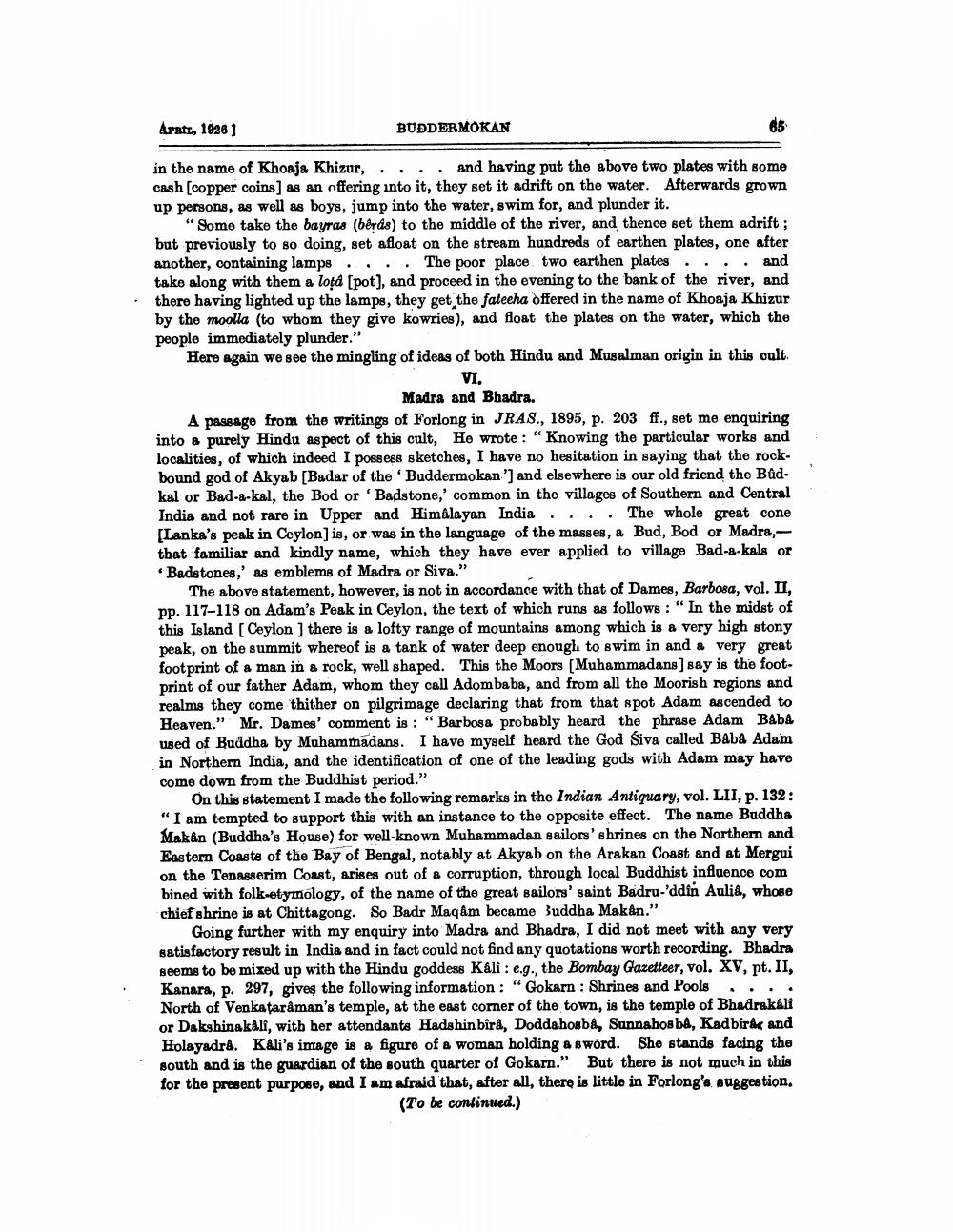________________
APRIL, 1926 )
BUDDERMOKAN
in the name of Khoaja Khizur,... and having put the above two plates with some cash [copper coins) as an offering into it, they set it adrift on the water. Afterwards grown up persons, as well as boys, jump into the water, swim for, and plunder it.
"Some take the bayras (bērds) to the middle of the river, and thence set them adrift; but previously to so doing, set afloat on the stream hundreds of earthen plates, one after another, containing lamps.... The poor place two earthen plates....and take along with them a lota (pot], and proceed in the evening to the bank of the river, and there having lighted up the lamps, they get the fateeha offered in the name of Khoaja Khizur by the moolla (to whom they give kowries), and float the plates on the water, which the people immediately plunder." Here again we see the mingling of ideas of both Hindu and Musalman origin in this cult.
VI.
Madra and Bhadra. A passage from the writings of Forlong in JRAS., 1895, p. 203 ff., set me enquiring into & purely Hindu aspect of this cult, He wrote: “Knowing the particular works and localities, of which indeed I possess sketches, I have no hesitation in saying that the rockbound god of Akyab [Badar of the Buddermokan '] and elsewhere is our old friend the Badkal or Bad-a-kal, the Bod or 'Badstone,' common in the villages of Southern and Central India and not rare in Upper and Himalayan India. ... The whole great cone [Lanka's peak in Ceylon) is, or was in the language of the masses, a Bud, Bod or Madra, that familiar and kindly name, which they have ever applied to village Bad-a-kals or Badstones,' as emblems of Madra or Siva."
The above statement, however, is not in accordance with that of Dames, Barbosa, vol. II, pp. 117-118 on Adam's Peak in Ceylon, the text of which runs as follows: "In the midst of this Island Ceylon) there is a lofty range of mountains among which is a very high stony peak, on the summit whereof is a tank of water deep enough to swim in and a very great footprint of a man in a rock, well shaped. This the Moors (Muhammadans] say is the footprint of our father Adam, whom they call Adombaba, and from all the Moorish regions and realms they come thither on pilgrimage declaring that from that spot Adam ascended to Heaven." Mr. Dames' comment is: "Barbosa probably heard the phrase Adam Baba used of Buddha by Muhammadans. I have myself heard the God Siva called Baba Adam in Northern India, and the identification of one of the leading gods with Adam may have come down from the Buddhist period."
On this statement I made the following remarks in the Indian Antiquary, vol. LII, p. 132: "I am tempted to support this with an instance to the opposite effect. The name Buddha Makan (Buddha's House) for well-known Muhammadan sailors' shrines on the Northern and Eastern Coasts of the Bay of Bengal, notably at Akyab on the Arakan Coast and at Mergui on the Tenasserim Coast, arises out of a corruption, through local Buddhist influence com bined with folk etymology, of the name of the great sailors' saint Badru-'ddin Aulia, whose chief shrine is at Chittagong. So Badr Maqam became Buddha Makan."
Going further with my enquiry into Madra and Bhadra, I did not meet with any very satisfactory result in India and in fact could not find any quotations worth recording. Bhadra Beems to be mixed up with the Hindu goddess Káli : e.g., the Bombay Gazetteer, vol. XV, pt. II, Kanara, p. 297, gives the following information: “Gokarn: Shrines and Pools . . . . North of Venkataraman's temple, at the east corner of the town, is the temple of Bhadrakali or Dakshinakali, with her attendants Hadahin birà, Dodda hogba, Sunnahos ba, Kadbir and Holayadra. Kali's image is a figure of a woman holding a sword. She stands facing the south and is the guardian of the south quarter of Gokarn." But there is not much in this for the present purpose, and I am afraid that, after all, there is little in Forlong's, suggestion.
(To be continued.)




